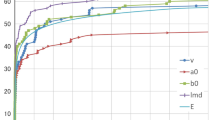Abstract
Let \(\alpha \) and \(\beta \) be two algebraic numbers, \(F={{\mathbb {Q}}}(\alpha ,\beta )\) and \(d=[F:{{\mathbb {Q}}}] \ge 2\). By the primitive element theorem, for all but finitely many rational numbers r we have \(F={{\mathbb {Q}}}(\alpha +r\beta )\). A straightforward argument implies that the number of exceptional r, namely, those \(r \in {{\mathbb {Q}}}\) for which \({{\mathbb {Q}}}(\alpha +r\beta )\) is a proper subfield of F, is at most \((d-1)^2\). We show that the number of exceptional r is at most d. On the other hand, we give an example showing the number of exceptional r can be greater than \(\big (\frac{\log d}{\log \log d}\big )^2\) for infinitely many \(d \in {\mathbb {N}}\).
Similar content being viewed by others
References
T. Arnóczki and G. Nyul, Minimal index of bicyclic biquadratic number fields, Rocky Mountain J. Math. 50 (2020), 1–8.
D. Bagio and A. Paques, A generalized primitive element theorem, Math. J. Okayama Univ. 49 (2007), 171–181.
N. Berry, A. Dubickas, N. D. Elkies, B. Poonen and C. J. Smyth, The conjugate dimension of algebraic numbers, Q. J. Math. 55 (2004), 237–252.
I. Del Corso and R. Dvornicich, Number fields with the same index, Acta Arith. 102 (2002), 323–337.
M. Drmota and M. Skałba, On multiplicative and linear independence of polynomial roots, in: Contributions to general algebra, 7 (Vienna, 1990), pp. 127–135, Hölder-Pichler-Tempsky, Vienna, 1991.
A. Dubickas, On the degree of a linear form in conjugates of an algebraic number, Illinois J. Math. 46 (2002), 571–585.
H. H. Kim and Z. Wolske, Number fields with large minimal index containing quadratic subfields, Int. J. Number Theory 14 (2018), 2333–2342.
H. H. Kim and Z. Wolske, Pure cubic fields with large minimal index, Acta Arith. 182 (2018), 271–277.
S. Lang, Algebra, 3rd ed., Graduate Texts in Mathematics 211, Springer-Verlag, New York, 2002.
J. S. Milne, Fields and Galois Theory (v4.61), Available at https://www.jmilne.org/math/CourseNotes/FT.pdf, 2020.
H. Osada, The Galois groups of the polynomials \(X^n+aX^l+b\), J. Number Theory 25 (1987), 230–238.
G. A. Pogudin, The primitive element theorem for differential fields with zero derivation on the ground field, J. Pure Appl. Algebra 219 (2015), 4035–4041.
C. J. Smyth, Conjugate algebraic numbers on conics, Acta Arith. 40 (1982), 333–346.
C. J. Smyth, Additive and multiplicative relations connecting conjugate algebraic numbers, J. Number Theory 23 (1986), 243–254.
J. Sonn and H. Zassenhaus, On the theorem on the primitive element, Amer. Math. Monthly 74 (1967), 407–410.
B. K. Spearman, Q. Yang and J. Yoo, Minimal indices of pure cubic fields, Arch. Math. (Basel) 106 (2016), 35–40.
J. L. Thunder and J. Wolfskill, Algebraic integers of small discriminant, Acta Arith. 75 (1996), 375–382.
Acknowledgements
I thank the referee for some useful remarks. This research has received funding from European Social Fund (Project No. 09.3.3-LMT-K-712-01-0037) under grant agreement with the Research Council of Lithuania (LMTLT).
Author information
Authors and Affiliations
Corresponding author
Additional information
Communicated by B. Sury.
Rights and permissions
About this article
Cite this article
Dubickas, A. An effective version of the primitive element theorem. Indian J Pure Appl Math 53, 720–726 (2022). https://doi.org/10.1007/s13226-021-00166-w
Received:
Accepted:
Published:
Issue Date:
DOI: https://doi.org/10.1007/s13226-021-00166-w



